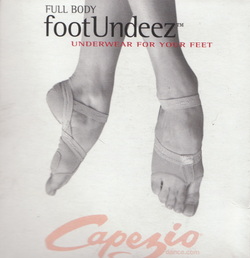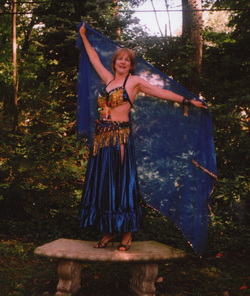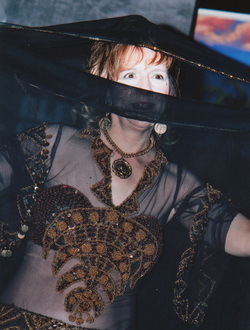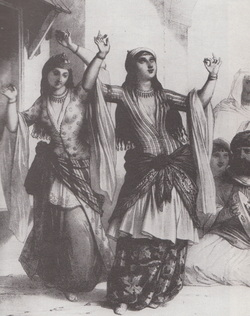
When I learned to belly dance, I danced in heels. My instructors were cabaret club performers who regularly danced in heels and urged their students to do the same.
Heels have the advantage of automatically lifting the hip. This makes belly dance moves more pronounced and easier to perform. However, they also require a great deal of balance. On occasion, especially during a cabaret performance with a questionable floor
(like in a restaurant or party center where food and beverages are served and often spilled) I will wear ballroom shoes. Ballroom shoes are purely for dancing indoors. These are not street shoes as the soles are a fine, delicate suede. This affords flexibility of the sole for dancing. The shoes are often dressy with straps that keep the shoe on the foot during dance moves. They are pretty and practical but also expensive. Prices begin at around $50 and can go into the hundreds. They also have a limited lifespan depending on use. Heel height is from 2-inches to 3-inches. I prefer the 2 ½-inch height in a neutral shade to match any costume. Before purchasing it is best to try on the shoes and try some common dance moves. Select what is comfortable for you. You must be comfortable and confident when dancing.
These days, most belly dancers prefer to dance barefoot because they feel it is more authentic. The feet also feel more grounded to the earth and the earth becomes one with the dancer. However, most dancers rise to their tiptoes to elongate the hip and to accent hip moves. Though bare feet are more natural, exposing the foot can create many dangers. Depending on where you dance, conditions may not be conducive to bare feet.
Concrete, grass with possible rocks and pebbles, dirty floors may not be something you wish to subject your feet to. For example, when I was in Egypt, Dina the famous dancer was performing on a carpeted stage. One would expect a carpeted stage to be safe, right? Wrong. She stopped mid-performance in pain. She bent to remove a shard of glass from her foot. Being the trooper that she is, she continued to dance. If it could happen to her, it can happen to anyone. A dancer can get seriously injured.
To combat accidents, there are alternatives to bare feet that create the natural appearance while protecting the foot. I love Capezio's Full Foot Undies. They are lightweight, snug, flexible with split suede soles and allow the toes to be free. They protect the foot from debris while allowing the toes to be free and flexible. I wear these to instruct and perform, even on grass. They match your complexion and come in various skin tones. I also like suede half-sole lyrical sandals. They match the foot, keep the heel bare but protect the delicate arch of the foot. They match any style of costume and are snug enough to the foot to allow for natural movement. I would not wear either of these on concrete, asphalt or in questionable environments.
Many dancers prefer the Hermes sandal. These are neutral-color delicate leather gladiator-style sandals that tie up the calf. They have an ancient Roman look that lends itself to Middle Eastern costuming. Though many dancers swear by them, I find the ties bothersome.
For performing, many dancers like Capezio's Pedini, a soft, split sole shoe with a slight heel. It is flexible, dressy and protects the foot.
For instructing and for workshops, I often wear soft ballet slippers, if I don't want my toes exposed.These are of soft leather with an elastic strap across the instep for support. Mine have a whole sole of suede. Some dancers prefer the half-sole for additional flexibility. Ballet slippers can also be found in a less expensive canvas. Though I wear ballet slippers, I do find them a bit restricting. Toes tend to be constricted. Yet, they do protect the feet from questionable floors. Capezio has a new product, the Freeform split sole shoe that is like a jazz shoe/ballet slipper alternative that comes in flesh tones. It also protects the entire foot, covering the toes.
A less expensive alternative is to wear Isotoner slippers. They come in neutrals, gold and silver and other fashionable colors. They are comfortable and stay on the feet. I do find that sewing elastic across he instep adds support and prevents slippage.
Students often wear socks to class. They protect the feet but can be slippery on wood and tile floors. Better than barefoot in most cases, though. Some find that slipper socks with treads work better.
Only you can determine what footwear is comfortable and desirable. Try out different types. When you dance you want to be comfortable and confident.
Remember, as the Chinese proverb states, “A journey of a thousand miles begins with a single step.”
Disclaimer: I do not work for Capezio nor am I profiting from them. I am only using the photograph of the box their product comes in to promote my favorite dance shoe. Purely a personal opinion.



 RSS Feed
RSS Feed